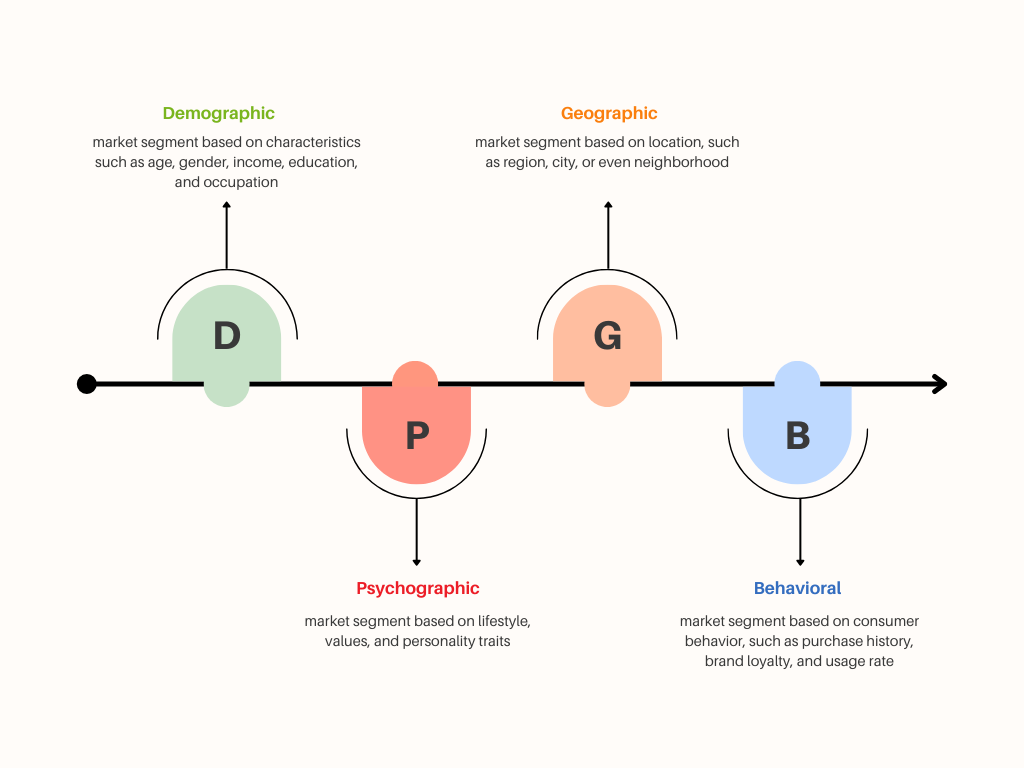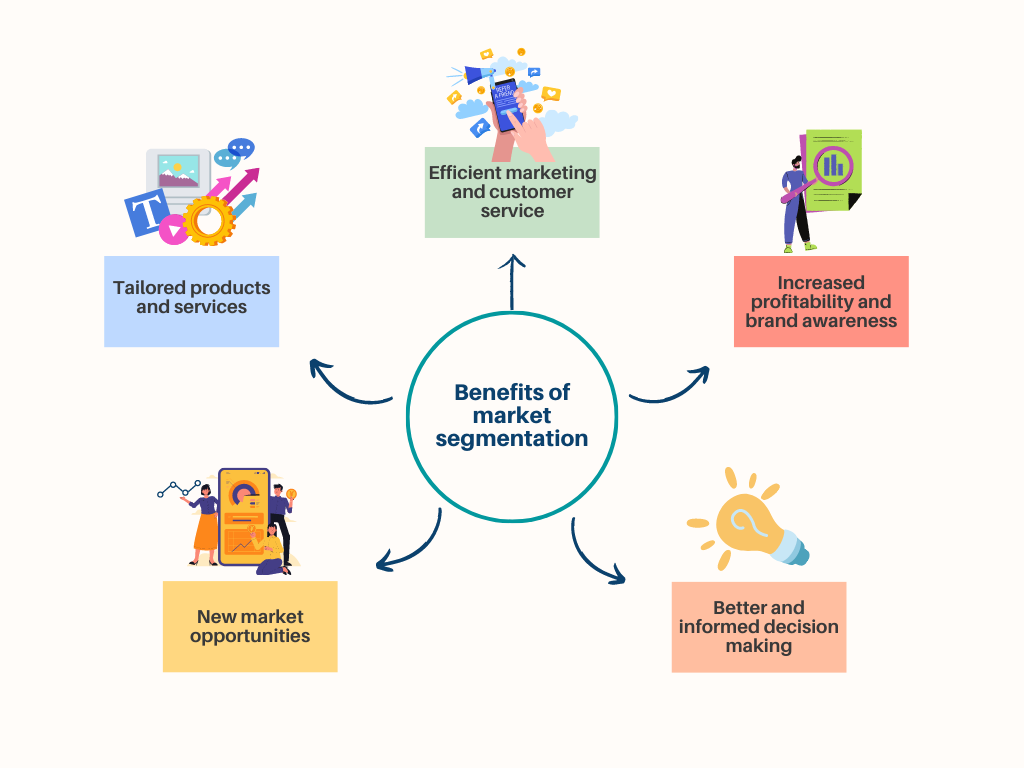Market segmentation is the process of dividing a larger market into smaller subsets of consumers who have similar needs or exhibit similar characteristics. Being an essential aspect of market research, market segmentation allows businesses to understand their target market in depth, thus enabling them to target specific groups of consumers effectively and helping them identify new growth opportunities.
But how does market segmentation in market research brings more value to businesses? Through this article, we will look at the importance of market segmentation in detail, including its role in market research, types, benefits, and how it can be implemented into a strategy.
Role of market segmentation in market research
Market segmentation in market research focuses on dividing a broader market into smaller segments or groups of audiences or consumers with similar behavior or personas. This helps businesses to experiment and target the audience to which they can cater, leading to more effective and efficient marketing efforts.
Market research is the process of gathering, analyzing, and interpreting any information about a product, service, or market and its potential customer base. With the help of market segmentation, businesses can identify the specific needs and characteristics of each group, which allows them to tailor their products or services to meet those needs more effectively.
For example, a business that sells athletic shoes may use demographic segmentation to divide the market based on age, gender, and income. This can help the business to identify differences in consumer behavior and needs based on these characteristics. For instance, they may find that younger consumers are more likely to prioritize fashion over function, while older consumers may prioritize comfort and support. By understanding these differences, the business can develop products and marketing campaigns that are more tailored to the specific needs of each segment.
Market segmentation also allows businesses to understand the size and growth potential of each segment, which can be used to identify new growth opportunities.
Additionally, market segmentation helps businesses identify and target profitable segments of their market. By understanding the specific needs and characteristics of different segments, businesses can identify the most profitable segments and allocate resources accordingly. This can help businesses to maximize their ROI and increase overall profitability.
Overall, the role of market segmentation in market research is to provide businesses with a more detailed understanding of their target market, which can be used to develop more effective products/ services, marketing campaigns, and business strategies.
Types of market segmentation
There are several different types of market segmentation that businesses can use to divide their market. Some of the most common and most used are demographic, geographic, psychographic, and behavioral segmentations.

Demographic segmentation
This type of segmentation divides the market based on characteristics such as age, gender, income, education, and occupation. For example, a business that sells children’s toys may segment the market based on age, targeting its marketing efforts towards parents of young children. Similarly, a business that sells luxury watches may segment the market based on income, targeting its marketing efforts towards high-income individuals.
Geographic segmentation
This type of segmentation divides the market based on location, such as region, city, or even neighborhood. For example, a business that sells outdoor gear may segment the market based on geographic location, targeting its marketing efforts towards regions with a high concentration of outdoor enthusiasts. This can also be used to identify new opportunities for growth in different regions or cities.
Psychographic segmentation
This type of segmentation divides the market based on lifestyle, values, and personality traits. For example, a business that sells organic food products may segment the market based on consumers’ attitudes towards health and the environment, targeting their marketing efforts towards consumers who are particularly health-conscious or environmentally-conscious.
Behavioral segmentation
This type of segmentation divides the market based on consumer behavior, such as purchase history, brand loyalty, and usage rate. For example, a business that sells mobile phones may segment the market based on consumer behavior, targeting its marketing efforts towards heavy mobile phone users or consumers with a history of purchasing expensive mobile phones.
These are the main types of market segmentation; however, businesses can also use combinations of these segmentation methods to gain a more detailed understanding of their target market. Additionally, businesses can also use other methods like value-based, benefit based, etc. In fact, by combining different types of segmentations, businesses can gain a more comprehensive understanding of their target market.
Benefits of market segmentation
Market segmentation offers many benefits to businesses, some of those of listed below:
Tailored products and services
- By understanding the specific needs and characteristics of different segments, businesses can develop products and services that are tailored to meet those needs more effectively.
- This can lead to increased customer satisfaction, as well as increased sales and revenue.
More efficient marketing
- By targeting specific audience personas, businesses can develop more efficient marketing campaigns that are more likely to reach their target audience.
- This can help to reduce marketing costs and increase the effectiveness of marketing efforts.
Increased profitability
- By identifying and targeting the most profitable segments of the market, businesses can increase their overall profitability.
- By allocating resources toward the most profitable segments, businesses can maximize their return on investment.

New market opportunities
- By identifying new market segments, businesses can identify new growth opportunities.
- This can help businesses to expand into new markets and increase their overall market share.
Better decision making
- By understanding the specific needs and characteristics of different segments, businesses can make more informed decisions about product development, marketing, and business strategy.
- This can help businesses to stay ahead of the competition and maintain a competitive advantage in the market.
Improved customer service
- By understanding the specific needs and characteristics of different segments, businesses can develop customer service strategies that are tailored to meet those needs.
- This can lead to increased customer satisfaction and loyalty.
Increased brand awareness
- By targeting specific segments of the market, businesses can increase brand awareness among their target audience.
- This can lead to increased sales and revenue in the long term.
Strategizing and implementing market segmentation
Implementing a market segmentation strategy involves several steps. Below is a brief of the overall process.
Identifying the market segments
- The first step in implementing a market segmentation strategy is to identify the different segments of the market.
- This can be done through market research, which can include surveys, focus groups, and other data collection methods.
- Businesses can use various segmentation methods, such as demographic, geographic, psychographic, and behavioral, to identify different segments of the market.
Evaluating the segments
- Once the segments have been identified, businesses should assess each segment to determine their potential value.
- Factors that must be considered include the size of the segment, its growth potential, and profitability.
- By evaluating the segments, businesses can identify the most attractive segments to target.
Selecting the target segments
- After evaluating the segments, businesses should select the segments that they will target with their products or services.
- This decision should be based on the evaluation of the segments, as well as the business’s overall goals and resources.
- It’s important to select segments that are both large enough and attractive enough to be profitable.
Developing a value proposition
- A value proposition is a statement that explains the unique benefits that a business’s products or services will provide to its target segments.
- Businesses should develop a value proposition for each target segment, which will serve as the basis for the business’s marketing and sales efforts.
- This statement should be communicated clearly and consistently across all marketing channels.
Implementing the segmentation strategy
- Once the target segments have been identified and a value proposition has been developed, businesses can begin implementing their segmentation strategy.
- This can include developing products or services that meet the specific needs of each target segment, as well as developing marketing campaigns that will reach and resonate with each segment.
- It’s also important to continuously monitor and evaluate the success of the strategy and make necessary adjustments.
Review and analysis
- The final step is to review and analyze the performance of the market segmentation strategy.
- Businesses should track and measure key performance indicators such as sales, revenue, market share, and customer satisfaction to determine the success of their strategy.
- Based on the results, businesses can make necessary adjustments to improve their strategy in the future.
By following these steps, businesses can develop a market segmentation strategy that will help them better understand and target specific groups of consumers, leading to increased sales and profitability.
The bottom line
To conclude, market segmentation is a critical aspect and should not be overlooked. It may sound tricky or lengthy, but it gives first-hand knowledge and data, which can result in great ROI.
How can CleverX help you in making a perfect market segmentation strategy?
CleverX works with some of the leading professionals and experts in different industries, ensuring that raw, authentic, and first-hand data is concluded from each study. Further, it lets the business design custom-tailor the survey that can help it in finding niche-specific audience segments.
Interesting in learning more? Click to look at what we are doing, or sign up for free!

